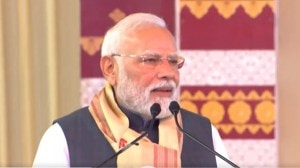Dripping with irrigation success
Drip irrigation growing year by year in Maharashtra,bringing rich rewards to farmers and helping save water
Rapidly growing adoption of micro-irrigation systems (drip and sprinkler) over the past seven years in Maharashtra has brought nearly 12 lakh hectares under its coverage,which is about one-third of the countrys total micro-irrigated area and also one-third of the states total irrigated area,which varies between 35 and 40 lakh hectares in a net cropped area of 175 lakh hectares. This has not just improved farm productivity but also saved precious water.
Subsidised MI schemes have been in place since 1986 but it is since 2005-06 that the technology has picked up dramatically,particularly in the horticulture belt of western Maharashtra and the cotton belt of Khandesh and Marathwada. The real growth story,however,has been that of the drip system,which accounts for about 8.5 lakh hectares.
Till 2004-05,the states drip-irrigated area was just over three lakh hectare. This has grown by over five lakh hectares in seven years. The year-on-year growth too has been successively higher,from 27,894 hectares in 2005-06 to 1,53,223 hectares in 2011-12.
The main crops for which MI systems are being used extensively are vegetables (1.8 lakh hectares),cotton (1.18),sugarcane (1.08) and fruits like banana,grape,papaya,pomegranate and of the citrus group (4.4).
We are noticing a change of mindset among farmers over the past few years, says Maharashtras principal secretary (agriculture) S K Goel. Earlier,farmers feared whether their capital cost would be recovered. Now after we have been able to explain and demonstrate to them that its hugely beneficial,the number of farmers adopting it is growing fast. It has been picking up very well in the crisis areas of Vidarbha,too,over the past three years.
The government also provides subsidy for wells as the source of water in non-command areas. Drip is preferred by farmers in non-command areas more since those in command areas dont have to bother about water supply, Goel says. A drip system typically costs a minimum of Rs 1 lakh per hectare. But the farmer fetches in multiples of that, Goel says. Various state and Central schemes provide subsidy up to 60 per cent to small and marginal farmers and 50 per cent to others. The National Mission on Micro-Irrigation,which began in 2010,too has helped a lot.
According to Goel,Maharashtra is spending Rs 500 crore annually on drip system subsidy,the highest by any state.
Use of modern technology also helps beat the power shortage. The Jain Irrigation Systems has brought automation technology that starts the system as soon as power supply resumes. So the farmer doesnt have to bother about erratic electric supply. A group of 100 farmers is now using this system in Sangli district, Goel says. Jain Irrigation Systems,Indias largest and the worlds second largest MI systems company,has also introduced a solar-operated drip irrigation system.
Studies have shown that drip use increases productivity by 27 per cent in cotton and 52 per cent in banana. Also,huge quantities of water are saved (citrus 61 per cent,sugarcane 56,cotton 53,banana 45).
Says award-winning farmer Rajendra Patil of Ade village in Jalgaon district: I started as a reluctant agriculturist on 1.5 acres in 2003 after quitting as a teacher. Today,I have 75 acres of leased land under banana,all thanks to drip irrigation.
Patil uses systems from Jain Irrigation Systems Ltd. The company helped me not just with drip but also with tissue culture,fertigation and organic manures, he says. From 2008 to 2010,I earned three times what I spent. After that however,increased fertiliser and labour costs have brought it down to two times.
Patil had a record-breaking harvest of eight trucks of bananas on a single day on August 28,2008,generating a huge interest among farmers in the village. I was the only farmer till then using drip. Now,95 per cent of farmers not just in my village but in all neighbouring villages are using it, says Patil,who earns an annual Rs 35-40 lakh.
Patil was honoured with the Punjabrao Deshmukh Krishi Ratna Puraskar of 2009 by the Akhil Bharatiya Krishak Samaj,and the Udyan Pandit Award by the Maharashtra government in 2010.
Onion farmer Hemchandra Patil of Panchak village,also in Jalgaon,started with 12 acres a few years ago and now has 30 acres. Patil today earns three times his spending on his crop and was awarded the Late Kantabai Jain Pandhara Kanda Navratna Puraskar in 2003 for the highest productivity of 19.66 tonnes per acre. He too uses Jain Irrigation systems.
The two were invited by Harvard Business School last year to share their experiences in farming. They were curious to know why farmers in India were committing suicide if we were doing so well, says Rajendra Patil. We said modern technology like drip irrigation and hard work can save farmers from disaster.
FROM A DRIP TO A FLOW
35-40 lakh hectares
Area under irrigation in Maharashtra,out of 175 lakh hectares net cropped area
12 lakh hectares
Under micro irrigation,or 1/3 of total under irrigation. Also 1/3 of country’s total micro-irrigated area
8.5 lakh hectares
Under drip irrigation
1.5 lakh hectares
Increase since last year
200%
Yield increase possible. Crop grows consistently and faster,resulting in early returns
70%
Saving possible in flood irrigation water,which can be used for other non-irrigated areas
30% Increase in fertiliser efficiency; administering fertilisers and chemicals through drip cuts labour cost.
Photos



- 01
- 02
- 03
- 04
- 05



























